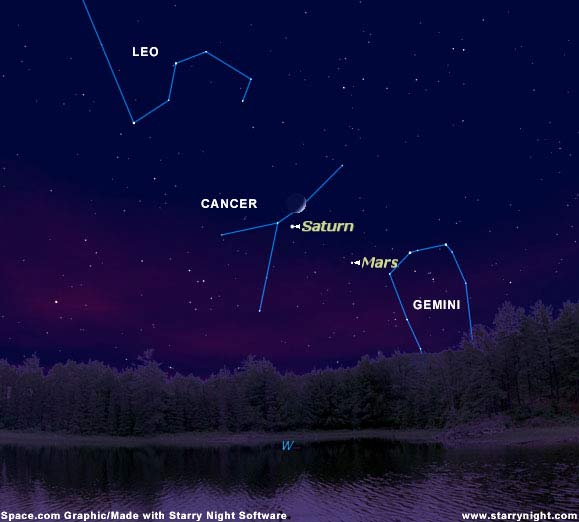Doorstep Astronomy: Stars and Planets Align

Something remarkable is about to happen in the evening sky. Three planets and a star cluster are converging for a close encounter you won't want to miss.
The action begins at sundown on Wednesday, May 31, when the crescent Moon glides by Saturn [Map]. You can see them side-by-side about halfway up the western sky, shining through the glow of sunset-very pretty.
Got a backyard telescope? Point it at the Moon. You'll see craters and mountains casting long shadows [Map & Guide]. Next, look at Saturn. The planet's rings will take your breath away [Gallery]. Also, look around Saturn. There's a star cluster! Saturn is sitting right next to "the Beehive," a swarm of stars 600 light years from Earth [Map].
But wait ...
This three-way convergence marks a spot in the sky you should watch as June unfolds, because things are about to get even more interesting.
After May 31, the Moon moves away, leaving Saturn and the Beehive behind. Keep an eye on Saturn every night. Before long you'll notice a dim red star approaching the ringed planet. That "star" is Mars. Every night it creeps closer to Saturn.
Fans of Star Trek, make the Vulcan "Live Long and Prosper" sign with your right hand. Hold it at arm's length. By Wednesday, June 7, both Mars and Saturn will fit inside the "V": sky map.
Breaking space news, the latest updates on rocket launches, skywatching events and more!
Thursday, June 15th, is a special night. En route to Saturn, Mars will pass directly in front of the Beehive. Scan the ensemble with binoculars or a small telescope. Red Mars is about 16 times brighter than the surrounding stars. It'll look like a red supernova has gone off inside the cluster-a wonderful photo-op for amateur astronomers.
Not done yet
Not enough? In mid-June, Mercury leaps out of the glare of the Sun, soaring into the evening sky not far from Saturn and Mars. Greatest visibility occurs around June 15, the same night Mars "explodes" in the Beehive. Mercury is easy to see even from over-lit cities.
Finally, the climax: On Saturday, June 17, Mars and Saturn draw so close together you might think they're going to collide. (They won't.) Stick out your pinky and hold it at arm's length. The two planets will fit behind the tip with room to spare. Mercury, meanwhile, hovers just below. Wow!
Mark your calendar: May 31, June 7, June 15, June 17. Four sunsets, three planets and a star cluster-not a bad way to end the day.
Editor's Note: SPACE.com will look at some of these events in greater detail in our June 9 Night Sky column.
- More about Saturn
- More about the Moon
Tony Phillips is a professional astronomer and science writer who received a PhD from Cornell University in 1992. He is best known for his authorship of Spaceweather.com. In his career, he has worked as a radio astronomer at Caltech and published more than 100 articles in research journals such as Nature, the Astrophysical Journal, and the Journal of Geophysical Research. Among his astronomical interests are planetary and neutron star magnetospheres, radio storms on Jupiter and cosmic rays.
